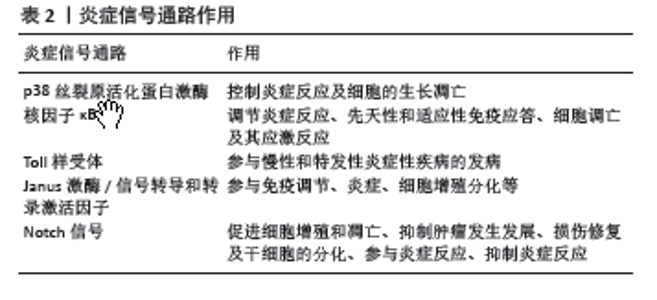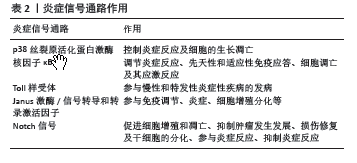Chinese Journal of Tissue Engineering Research ›› 2025, Vol. 29 ›› Issue (21): 4568-4575.doi: 10.12307/2025.200
Previous Articles Next Articles
Inflammatory signaling pathways in traditional Chinese medicine for treating fever after lumbar interbody fusion surgery
Fang Yuting, Peng Hong, Pang Yujie
- Nanyang Hospital of Traditional Chinese Medicine, Nanyang 473000, Henan Province, China
-
Received:2024-04-01Accepted:2024-05-24Online:2025-07-28Published:2024-12-06 -
Contact:Peng Hong, Associate chief physician, Nanyang Hospital of Traditional Chinese Medicine, Nanyang 473000, Henan Province, China -
About author:Fang Yuting, MS, Physician, Nanyang Hospital of Traditional Chinese Medicine, Nanyang 473000, Henan Province, China -
Supported by:Nanyang Science and Technology Research Project, No. 23KJGG133 (to PH)
CLC Number:
Cite this article
Fang Yuting, Peng Hong, Pang Yujie. Inflammatory signaling pathways in traditional Chinese medicine for treating fever after lumbar interbody fusion surgery[J]. Chinese Journal of Tissue Engineering Research, 2025, 29(21): 4568-4575.
share this article
Add to citation manager EndNote|Reference Manager|ProCite|BibTeX|RefWorks

2.1.1 p38丝裂原活化蛋白激酶(p38 mitogen-activated protein kinase,p38 MAPK)信号通路 p38 MAPK信号通路主要控制炎症反应及细胞的生长凋亡,p38 MAPK活性对正常的免疫和炎症反应很重要。炎性白细胞介素和肿瘤生长因子可诱导细胞内p38 MAPK信号通路被激活,调节炎症反应[13]。同时,缺氧或者组织内渗透压变化以及促炎因子可以激活p38 MAPK信号通路,p38 MAPK信号通路被激活后会产生大量炎症因子(白细胞介素1β、白细胞介素6、白细胞介素8、肿瘤坏死因子α)[14]。在炎症激发时,肝和肺巨噬细胞及脑内皮细胞释放脂质介质[15],前列腺素E2和细胞因子(白细胞介素1、白细胞介素6、肿瘤坏死因子α)[10]。 术后发热常见原因是白细胞介素1、白细胞介素6、肿瘤坏死因子α、干扰素γ热原细胞因子释放引起的炎症反应[16]。手术炎症反应致白细胞数量的增加,白细胞数量在术后恢复期间逐渐减少,术后体温升高是外科大手术后第1,2天的常见现象,而且术后白细胞介素6水平与体温值呈正比[17]。前列腺素由环氧合酶1和环氧合酶2的酶活性产生,可调节发热、疼痛感等,炎性细胞因子(白细胞介素1)可以促进环氧合酶表达,产生前列腺素E2,前列腺素E2作用于下丘脑使体温上升。 2.1.2 核因子κB信号通路 核因子κB是核转录因子,它负责调节炎症反应、先天性和适应性免疫应答、细胞凋亡及其应激反应等[18]。核因子κB家族包括核因子κB1、核因子κB2、REIA、RelB和c-Rel[19]。核因子κB的信号通路包括由p50、p65及c-Rel激活的经典通路,以及由核因子κB2、RelB激活的旁路通路等诱导的非典型通路[20-22]。 核因子κB激活会使增强促炎递质的表达,且与感染、失血和缺血再灌注损伤密切相关[23]。核因子κB信号通路激活的经典通路为:软组织损伤或感染时肿瘤坏死因子α、白细胞介素1等炎症细胞因子与受体结合,激活肿瘤坏死因子受体相关因子2或MEKK1,再激活IκB激酶,蛋白激酶G/蛋白激酶C也可活化IκB激酶,诱导促炎细胞因子的表达[24]。核因子κB信号通路激活的非经典通路:通过BAFF/BAFF-R、CD40L/CD40、Blys/LT-BR使非经典核因子κB信号通路激活[25-28]。炎症递质和氧化应激等诱导时,核因子κB通过细胞质暴露到细胞核中,加速DNA转录,调节炎症递质的表达[29]。 核因子κB不仅是重要的炎症信号通路,而且是细胞信号的枢纽及引起发热的重要途径,可以调控炎症细胞因子(白细胞介素1β、白细胞介素8、白细胞介素6)的表达,而炎症细胞因子肿瘤坏死因子α、白细胞介素1β又是发热的主要因子,所以核因子κB与术后发热密切相关[30-31]。 2.1.3 Toll样受体信号通路 Toll样受体参与慢性和特发性炎症性疾病的发病机制之中[32]。Toll样受体通过下游信号通路核因子κB,促进白细胞介素、干扰素、肿瘤坏死因子α等炎症因子表达,增加毛细血管通透性等,参与炎症反应[33]。Toll样受体4信号转导触发革兰阴性菌外膜的脂多糖,脂多糖诱导巨噬细胞中前列腺素E2并快速产生前列腺素E2导致发热[34-35]。有研究表明,机体感染期间出现发热可能与白细胞介素1或肿瘤坏死因子活性无关,因为机体微生物的产物可以通过Toll样受体到达下丘脑前体温调节中心的血管网络上而引起发热[36],细胞因子和Toll样受体均会导致感染期间发热。 2.1.4 Janus激酶/信号转导和转录激活因子(Janus kinases/ signal transducer and activator of transcription,JAK/STAT)信号通路 JAK信号转导和转录激活JAK/STAT信号通路[37]。 JAK/STAT信号通路被干扰素、白细胞介素10家族、gp130家族、γC家族等激活,参与免疫调节、炎症、细胞增殖分化等过程[38]。细胞因子与其受体结合,产生二聚化,促进JAKs聚合和磷酸化,JAKs与STATs的SH2结合,STATs被激活,以二聚体形式进入细胞核,促使基因转录[39]。 热原细胞因子白细胞介素1α/β、白细胞介素6、白细胞介素8、干扰素γ和解热因子白细胞介素10、肿瘤坏死因子α多种相互作用下均参与发热反应[40]。白细胞介素6与gp130结合,激活JAK/STAT通路,调节炎症反应[41]。现有研究表明,白细胞介素6是主要的致热因子,而白细胞介素6通过JAK/STAT信号通路参与炎症反应,所以JAK/STAT信号通路可能与发热具有关联。 2.1.5 Notch信号通路 Notch信号有受体(Notch1、Notch2、Notch3和Notch4)和配体(Jg1、Jg2、Dll1、Dll3和Dll4 ),Notch信号通路具有促进细胞增殖和凋亡、抑制肿瘤发生发展、损伤修复及干细胞的分化等[42-43]。巨噬细胞分化为M1和M2,M1释放肿瘤坏死因子α、白细胞介素1、白细胞介素6等细胞因子,激活Notch信号促进巨噬细胞分化M1型,参与炎症反应;抑制Notch信号诱导巨噬细胞分化M2型,抑制炎症反应和促进组织修复[44-45]。Notch信号转导在炎症性疾病、病毒和细菌感染免疫应答中起着重要作用[46-47]。炎症信号通路作用图见表2。"


2.2 中药及其复方治疗腰椎椎体间融合术后发热 腰椎椎体间融合术后发热多为非感染性发热,属中医“内伤发热”范畴,患者久病或手术创伤致人体气血阴阳的亏虚,气、血、湿等郁结壅遏而引起发热[12,48],可根据后路腰椎椎体间融合术后发热不同证型进行辨证论治。现代众多药理学研究结果表明活血类中药具有抗炎止痛、改善微循环等作用,有利于组织愈合,其复方通过不同机制发挥抗炎解热作用,目前,中药及其复方作用机制研究缺乏,需要加强深入研究。 2.2.1 中药复方 《正体类要》:“肢体损于外,则气血伤于内,营卫有所不贯,脏腑由之不和”。后路腰椎椎体间融合术是金刃损伤,包括术中的筋骨、气血损伤,术后的瘀血积滞、卧床休养,都会影响人体脏腑功能,而致发热。《温病条辨》:“秽湿着里,舌黄脘闷,气机不宣,久则酿热”,是湿郁发热;《诸病源候论》:“虚劳而热者,是阴气不足”,是阴虚发热;《脾胃论》:“脾胃气衰,元气不足,而心火独盛”,是气虚发热;《内外伤辨惑论》:“血虚发热,证象白虎……此病得之于饥困劳役”,是血虚发热;《血证论?发热》:“瘀血发热者,瘀血在肌肉则翕翕发热”,是血瘀发热;故发热病因病机可分为湿郁、阴虚、气虚、血虚、血瘀、部其中术后发热多由瘀和虚引起。 手术可致血脉受损,络破血溢,离经止血短期内难以消散而成为瘀血,故术后发热以血瘀为主兼气血亏虚,治疗上以补气养血,活血化瘀为主。后路腰椎椎体间融合术后服用青蒿鳖甲汤合十全大补汤加减,可降低退热时长及发热率,促进血红蛋白的恢复速度[49]。严佳宝等[50]纳入符合要求的后路腰椎椎体间融合术后瘀热互结证58例患者,研究表明术后常规治疗上加服桃核承气汤组患者炎症指标较对照组降低,且改善患者术后发热、便秘症状。部分研究结果表明清热活血汤[51]、大黄蛰虫汤[52]、身痛逐瘀汤[53]、自拟补气清热汤也可以改善术后发热症状[54]。现代药理研究表明活血化瘀中药可促进骨折断端毛细血管增生并促进软骨及膜内成骨、提高骨痂密度[55-56]。活血化瘀类中药具有改善微循环、抗氧化、抗炎镇痛等作用[57-58]。所以部分学者认为,手术损伤使脾胃脏腑气虚,加之术后大量补液及抗生素的使用,致湿邪内生,出现舌苔黏腻、脘腹闷满等湿阻内蕴症状,湿邪郁而化热[59]。孔畅等[60]临床研究纳入脊柱病术后90例湿阻发热患者,给予患者口服三仁汤主要改善患者湿热证的临床症状,促进脾胃功能的恢复,减少术后并发症发生。 2.2.2 中药单体及有效成分 现有实验研究表明单味中药单体及有效成分调节炎症信号通路的机制,抑制炎症反应,防治后路腰椎椎体间融合术后发热。淫羊藿的主要活性成分淫羊藿苷具有抗炎、抗氧化和抗凋亡作用[61],淫羊藿苷通过调节MAPK、核因子κB、Nrf2和磷脂酰肌醇3激酶/蛋白激酶B(phosphoinositide 3-kinase/protein kinase B,PI3K-Akt)抑制促炎信号通路[62]。姜黄根的主要成分姜黄素具有抗氧化、抗炎和神经保护作用[63],现代研究表明姜黄素通过抑制Toll样受体4表达,下调促炎因子,调节核因子κB、Nrf2信号通路来发挥抗炎作用[64]。藏红花素下调脂多糖刺激的巨噬细胞,影响核因子κB信号通路传导,抑制一氧化氮合酶的表达和一氧化氮的产生,发挥抗炎作用,藏红花素通过CAMK4-PI3K/Akt-Nrf2信号传导上调血红素加氧酶1表达,抑制炎症反应[65]。石斛茎提取物通过PI3K/Akt/p38-Nrf2信号通路上调血红素加氧酶1表达而抗炎[66]。延胡索中的去氢紫堇碱和延胡索乙素成分具有抗炎功效,去氢紫堇碱抑制促炎细胞因子表达,提高抗炎白细胞介素10的表达,延胡索乙素通过促进IκBα表达,抑制核因子κB信号通路的活化发挥抗炎作用[67]。川芎中的活性成分具有抗炎作用,藁本内酯、洋川芎内酯和新蛇床内酯可能通过环氧合酶2、EKR2、蛋白激酶C、JAK1、JAK2、JAK3、IKK-β、肿瘤坏死因子α影响炎症信号传递,发挥抗炎作用[68]。丹参通过抑制致炎因子活性,影响核因子κB信号通路的激活,发挥抗炎作用。现代药理研究表明活血化瘀类中药具有抗炎作用,主要通过核因子κB、MAPK、Nrf2-ARE信号通路抑制炎症反应[69],例如乳香[70-71]、没药[72]、益母草[73]、牛膝等[74]。 柴胡具有抗炎、解热等功效[75],柴胡提取物柴胡黄酮通过抑制脂多糖,影响巨噬细胞内炎症因子表达,发挥抗炎作用[76]。连翘通过抑制肿瘤坏死因子α及白细胞介素发挥抗炎、解热作用,也可能通过抑制Toll样受体4/核因子κB/白细胞介素6信号通路抗炎[77-78]。广藿香的挥发油(广藿香醇、广藿香酮、广藿香甲醇)通过抑制炎症因子发挥解热抗炎作用[79]。野菊花具有抗炎功效,其中野菊花总黄酮通过抑制核因子κB信号通路、炎症因子等抗炎;野菊花内酯下调核因子κB,抑制MAPK信号通路,下调炎症因子表达,发挥抗炎作用[80]。甘草抗炎主要的成分包括三萜皂苷类及多糖类,通过抑制细胞因子调控蛋白表达,调控信号通路,发挥抗炎作用[81-82]。金银花通过抑制炎症因子发挥解热抗炎作用[83-85]。"

| [1] WANG YL, LI XY, LIU L, et al. Oblique lumbar interbody fusion versus minimally invasive transforaminal lumbar interbody fusion for the treatment of degenerative disease of the lumbar spine: a systematic review and meta-analysis. Neurosurg Rev. 2023;46(1):100. [2] ALEEM IS, DREW B. Cochrane in CORR@:surgical versus non-surgical treatment for lumbar spinal stenosis. Clin OrthopRelat Res. 2017;475(11):2632-2637. [3] GBD 2021 LOW BACK PAIN COLLABORATORS. Global, regional, and national burden of low back pain, 1990-2020, its attributable risk factors, and projections to 2050: a systematic analysis of the Global Burden of Disease Study 2021. Lancet Rheumatol. 2023;5(6): e316-e329. [4] 郭卿,刘会玲,李身泰,等.基于运动疗法的预康复在腰椎间盘突出症手术患者中的应用研究[J].现代中西医结合杂志,2023, 32(20):2902-2905. [5] 张伟,姜盟盟,孙其志.腰椎术后非感染性发热的相关因素分析[J].中国矫形外科杂志,2020,28(18):1716-1718. [6] SOUTHWORTH SR, WOODWARD EJ, PENG A, et al. An integrated safety analysis of intravenous ibuprofen (Caldolor(®)) in adults . J Pain Res. 2015;8:753-765. [7] LEE JJ, KIM JH, JEON JH, et al. A retrospective controlled study of postoperative fever after posterior lumbar interbody fusion due to degenerative lumbar disease. Medicine (Baltimore). 2022;101(20): e29231. [8] SEO J, PARK JH, SONG EH, et al. Postoperative Nonpathologic Fever After Spinal Surgery: Incidence and Risk Factor Analysis. World Neurosurg. 2017;103:78-83. [9] 陈升富,李晓琳,王维刚,等.中药解热作用研究进展[J].中国临床药理学与治疗学,2022,27(3):334-344. [10] LAI J, WU H, QIN A. Cytokines in Febrile Diseases. J Interferon Cytokine Res. 2021;41(1):1-11. [11] HOPKINS SJ. Central nervous system recognition of peripheral inflammation: a neural, hormonal collaboration. Acta Biomed. 2007; 78 Suppl 1:231-247. [12] 耿捷,高书图,赵祚塨.中医药在骨科术后非感染性发热的应用探析[J].中医药导报,2010,16(9):82-83. [13] CUADRADO A, NEBREDA AR. Mechanisms and functions of p38 MAPK signalling. Biochem J. 2010;429(3):403-417. [14] ASHWELL JD. The many paths to p38 mitogen-activated protein kinase activation in the immune system. Nat Rev Immunol. 2006;6(7): 532-540. [15] GARAMI A, STEINER AA, ROMANOVSKY AA. Fever and hypothermia in systemic inflammation. Handb Clin Neurol. 2018;157:565-597. [16] NARAYAN M, MEDINILLA SP. Fever in the postoperative patient. Emerg Med Clin North Am. 2013;31(4):1045-1058. [17] SAAVEDRA F, MYBURG C, LANFRANCONI MB, et al. Fiebre postoperatoria en cirugía ortopédica y urológica [Postoperative fever in orthopedic and urologic surgery]. Medicina (B Aires). 2008;68(1):6-12. [18] O’DEA E, HOFFMANN A. NF-κB signaling. Wiley Interdiscip Rev Syst Biol Med. 2009;1(1):107-115. [19] HAYDEN MS, GHOSH S. Shared principles in NF-kappaB signaling. Cell. 2008;132(3):344-362. [20] SUN SC. The non-canonical NF-κB pathway in immunity and inflammation. Nat Rev Immunol. 2017;17(9):545-558. [21] POMA P. NF-κB and Disease. Int J Mol Sci. 2020;21(23):9181. [22] MOORTHY AK, HUANG DB, WANG VY, et al. X-ray structure of a NF-kappaB p50/RelB/DNA complex reveals assembly of multiple dimers on tandem kappaB sites. J Mol Biol. 2007;373(3):723-734. [23] ABRAHAM E. NF-kappaB activation. Crit Care Med. 2000;28(4 Suppl): N100-N104. [24] LAWRENCE T. The nuclear factor NF-kappaB pathway in inflammation. Cold Spring Harb Perspect Biol. 2009;1(6):a001651. [25] DE SILVA NS, SILVA K, ANDERSON MM, et al. Impairment of Mature B Cell Maintenance upon Combined Deletion of the Alternative NF-κB Transcription Factors RELB and NF-κB2 in B Cells. J Immunol. 2016; 196(6):2591-2601. [26] CRISWELL LA. Gene discovery in rheumatoid arthritis highlights the CD40/NF-kappaB signaling pathway in disease pathogenesis. Immunol Rev. 2010;233(1):55-61. [27] CHANG SK, ARENDT BK, DARCE JR, et al. A role for BLyS in the activation of innate immune cells. Blood. 2006;108(8): 2687-2694. [28] YU H, LIN L, ZHANG Z, et al. Targeting NF-κB pathway for the therapy of diseases: mechanism and clinical study. Signal Transduct Target Ther. 2020;5(1):209. [29] LIANG H, YANG X, LIU C, et al. Effect of NF-κB signaling pathway on the expression of MIF, TNF-α, IL-6 in the regulation of intervertebral disc degeneration. J Musculoskelet Neuronal Interact. 2018;18(4):551-556. [30] 焦谊,刘志凤,于天源,等.“退热六法”对不同月龄幼兔退热效果及TLR4/NF-κB信号通路的影响[J].长春中医药大学学报,2022, 38(7):746-751. [31] BLOMQVIST A, ENGBLOM D. Neural Mechanisms of Inflammation-Induced Fever. Neuroscientist. 2018;24(4):381-399. [32] FITZGERALD KA, KAGAN JC. Toll-like Receptors and the Control of Immunity. Cell. 2020;180(6):1044-1066. [33] FUKATA M, VAMADEVAN AS, ABREU MT. Toll-like receptors (TLRs) and Nod-like receptors (NLRs) in inflammatory disorders. Semin Immunol. 2009;21(4):242-253. [34] ROMANOVSKY AA, STEINER AA, MATSUMURA K. Cells that trigger fever. Cell Cycle. 2006;5(19):2195-2197. [35] STEINER AA, CHAKRAVARTY S, RUDAYA AY, et al. Bacterial lipopolysaccharide fever is initiated via Toll-like receptor 4 on hematopoietic cells. Blood. 2006;107(10):4000-4002. [36] SANTACROCE L, COLELLA M, CHARITOS IA, et al. Microbial and Host Metabolites at the Backstage of Fever: Current Knowledge about the Co-Ordinate Action of Receptors and Molecules Underlying Pathophysiology and Clinical Implications. Metabolites. 2023;13(3):461. [37] SARAPULTSEV A, GUSEV E, KOMELKOVA M, et al. JAK-STAT signaling in inflammation and stress-related diseases: implications for therapeutic intervention. Mol Biomed. 2023;4(1):40. [38] LIU J, WANG F, LUO F. The Role of JAK/STAT Pathway in Fibrotic Diseases: Molecular and Cellular Mechanisms. Biomolecules. 2023;13(1):119. [39] 赵九洲,姜晓旭,李宏伟,等. JAK-STAT信号通路与巨噬细胞炎症调控的研究进展[J]. 癌变·畸变·突变,2020,32(5):402-404+408. [40] NESPITAL T, STROUS GJ. The Jak/STAT signaling pathway is downregulated at febrile temperatures. PLoS One. 2012;7(11): e49374. [41] ZHANG L, SHI W, LIU J, et al. Interleukin 6 (IL-6) Regulates GABAA Receptors in the Dorsomedial Hypothalamus Nucleus (DMH) through Activation of the JAK/STAT Pathway to Affect Heart Rate Variability in Stressed Rats. Int J Mol Sci. 2023;24(16):12985. [42] ZHOU B, LIN W, LONG Y, et al. Notch signaling pathway: architecture, disease, and therapeutics. Signal Transduct Target Ther. 2022;7(1):95. [43] GARIS M, GARRETT-SINHA LA. Notch Signaling in B Cell Immune Responses. Front Immunol. 2021;11:609324. [44] 程静,万磊,赵磊,等.基于Notch1信号通路调控巨噬细胞极化改善佐剂关节炎大鼠关节炎症的机制[J].海南医学院学报,2023, 29(23):1780-1785. [45] SUAREZ RODRIGUEZ F, SANLIDAG S, SAHLGREN C. Mechanical regulation of the Notch signaling pathway. Curr Opin Cell Biol. 2023; 85:102244. [46] GALLENSTEIN N, TICHY L, WEIGAND MA, et al. Notch Signaling in Acute Inflammation and Sepsis. Int J Mol Sci. 2023;24(4):3458. [47] DERADA TROLETTI C, LOPES PINHEIRO MA, CHARABATI M, et al. Notch signaling is impaired during inflammation in a Lunatic Fringe-dependent manner. Brain Behav Immun. 2018;69:48-56. [48] 王蓉燕齐,韩赵成,樊欢欢,等.从内伤发热论颅脑手术后非感染性发热的中医辨证[J].天津中医药大学学报,2022,41(2):173-176. [49] 崔玉石.青蒿鳖甲汤联合十全大补方治疗腰椎术后非感染性发热的疗效评价[D].北京:北京中医药大学,2022. [50] 严佳宝,刘秉新,郭俊彪,等.桃核承气汤对腰椎术后瘀热互结证的疗效[J].广东医学,2023,44(7):838-841. [51] 张高翔,王德成,苏凤哲,等.清热活血法治疗腰椎间盘突出症术后发热的临床观察[J].河北医药,2020,42(19):2943-2946. [52] 张智伟,胡仕祥,赵哲.大黄蛰虫汤治疗外科术后非感染性发热(血瘀证)疗效研究[J].中国中医急症,2022,31(1):46-48+66. [53] 杨鸫祥.身痛逐瘀汤治疗骨伤科术后非感染性发热临床观察[J].中华中医药学刊,2013,31(6):1427-1428. [54] 麻晓璐,应志强.自拟补气清热汤治疗胸腰椎骨折术后非感染性发热37例[J].浙江中医杂志,2019,54(3):201-202. [55] 顾天雯,燕文海,王姣姣,等.活血化瘀方结合手法复位治疗A型胸腰段骨折的效果及对骨代谢指标的影响[J].湖北中医药大学学报,2023,25(5):74-76. [56] 曾意荣,樊粤光,刘红,等.补肾活血中药对大鼠骨髓间充质干细胞体外增殖的影响[J]. 中药新药与临床药理,2007,18(2):93-96. [57] 杨宇,黄兴琳,江忠敏,等.中药红花化学成分与药理作用研究新进展[J].中华中医药学刊,2023,41(10):119-126. [58] 邓静,颜丹娜,吴孟华,等.桃仁药性与应用的古今比较[J].中药材,2023,46(4):1034-1042. [59] 杨晓寰,张敏,纪璇,等.上呼吸道感染患者抗生素治疗前后中医证型变化关系[J].天津中医药大学学报,2012,31(1):17-19. [60] 孔畅,林定坤,李永津,等.三仁汤治疗脊柱病术后湿阻发热的临床研究[J].时珍国医国药,2006(6):1045-1046. [61] VERMA A, AGGARWAL K, AGRAWAL R, et al. Molecular mechanisms regulating the pharmacological actions of icariin with special focus on PI3K-AKT and Nrf-2 signaling pathways. Mol Biol Rep. 2022;49(9): 9023-9032. [62] LUO Z, DONG J, WU J. Impact of Icariin and its derivatives on inflammatory diseases and relevant signaling pathways. Int Immunopharmacol. 2022;108:108861. [63] PATEL SS, ACHARYA A, RAY RS, et al. Cellular and molecular mechanisms of curcumin in prevention and treatment of disease. Crit Rev Food Sci Nutr. 2020;60(6):887-939. [64] REIS L, OLIVEIRA MK, ROJAS VCT, et al. Curcumin attenuates LPS-induced sickness behavior and fever in rats by modulating Nrf2 activity. Neurosci Lett. 2022;781:136680. [65] KIM JH, PARK GY, BANG SY, et al. Crocin suppresses LPS-stimulated expression of inducible nitric oxide synthase by upregulation of heme oxygenase-1 via calcium/calmodulin-dependent protein kinase 4. Mediators Inflamm. 2014;2014:728709. [66] LEE YJ, KIM JH, KIM Y. Dendrobium moniliforme Stem Extract Inhibits Lipoteichoic Acid-Induced Inflammatory Responses by Upregulation of Heme Oxygenase-1. J Microbiol Biotechnol. 2018;28(8): 1310-1317. [67] 程芳,胡坤敏,朱珊. 活血化瘀类中药抗炎机制研究进展[J]. 中国医药导报,2023,20(8):46-49+65. [68] 马宁宁,范姗姗,李欣,等. 川芎的抗炎物质筛选及其作用机制分析[J]. 中国实验方剂学杂志,2018,24(18):140-146. [69] 戴娜,王从安,师彬.丹参活性成分防治骨关节炎作用机制的研究进展[J].环球中医药,2023,16(10):2147-2152. [70] 赵子樟,李佳晌,宿树兰,等. 基于网络药理学及细胞实验的乳香-没药功效成分抗炎机制研究[J]. 中国中药杂志,2021,46(21): 5674-5682. [71] 赵丽辉,赵子樟,李佳晌,等.乳香、没药活性成分KTDA、FSA及其配伍的抗炎镇痛作用及机制研究[J].中药新药与临床药理, 2022,33(11):1460-1465. [72] 杨宝,徐莲莲,陈芳有,等.没药化学成分及抗炎活性研究[J].中草药,2023,54(9):2716-2721. [73] 李艳,苗明三.益母草药理作用研究进展[J].中华中医药学刊,2023, 41(5):102-106. [74] 杨正汉,赵继荣,王兴盛,等.牛膝及其有效成分防治腰椎间盘突出症的研究进展[J].中华中医药学刊,2023,41(1):143-147. [75] 王惠,冯玛莉,张越,等.藏柴胡与北柴胡急性毒性、解热、抗炎作用的对比研究[J].世界科学技术-中医药现代化,2020,22(5): 1517-1523. [76] 胡建燃,李平,赵红梅,等.柴胡总黄酮的体外抗炎及抗氧化活性研究[J].中国食品添加剂,2023,34(9):82-88. [77] 郑立,汤韵秋,余琳媛,等. 连翘挥发油自微乳的制备及解热作用[J]. 中华中医药学刊,2020,38(3):149-153. [78] 席亚莉,白雅雯,麻春杰,等. 连翘的免疫调节活性成分及作用机制研究进展[J]. 中华中医药学刊,2023,41(12):194-197. [79] 徐雯,吴艳清,丁浩然,等. 广藿香的药理作用及机制研究进展[J]. 上海中医药杂志,2017,51(10):103-106. [80] 楚继敏,孙素姣. 野菊花活性成分的抗炎机制研究进展[J]. 中医药临床杂志,2021,33(10):2023-2026. [81] 崔园园,刘佳昕,邢博宇,等.甘草抗炎活性物质基础及其作用机制研究进展[J].中华中医药学刊,2024,42(6):99-103+276. [82] 韩维维,钟晴,张蓉,等. 甘草有效成分及其作用机制研究进展[J]. 生命的化学,2023,43(12):1956-1962. [83] SHANG X, PAN H, LI M, et al. Lonicera japonica Thunb.: ethnopharmacology, phytochemistry and pharmacology of an important traditional Chinese medicine. J Ethnopharmacol. 2011; 138(1):1-21. [84] 曾安琪,华桦,陈朝荣,等. 金银花、山银花抗炎药理作用研究[J]. 中国中药杂志,2020,45(16):3938-3944. [85] 关秀锋,王锐,李晓龙,等. 金银花的化学成分与药理作用研究新进展[J]. 化学工程师,2020,34(4):59-62. [86] LIU C, CHU D, KALANTAR-ZADEH K, et al. Cytokines: From Clinical Significance to Quantification. Adv Sci (Weinh). 2021;8(15): e2004433. [87] 陈升富,李晓琳,王维刚,等. 中药解热作用研究进展[J]. 中国临床药理学与治疗学,2022,27(3):334-344. [88] BLOMQVIST A. Prostaglandin E2 Production by Brain Endothelial Cells and the Generation of Fever. DNA Cell Biol. 2023;42(3):107-112. [89] XUE R, MIAO YF, YANG JC, et al. [Prostaglandin(PG) E2 in regulation of immunity and inflammatory diseases]. Sheng Li Ke Xue Jin Zhan. 2011;42(3):165-168. [90] YE K, LI Y, XING Y, et al. A Randomized Study on the Prophylactic Use of Acetaminophen to Prevent Fever after the Removal of Drainage Tubes for Lumbar Surgery. Orthop Surg. 2023;15(2):440-447. [91] LI Z, SHEN J, LI Q, et al. Drug Fever Induced by Piperacillin/Tazobactam in a Scoliosis Patient: A Case Report. Medicine (Baltimore). 2015; 94(46):e1875. [92] XU D, HU X, ZHANG H, et al. Analysis of risk factors for deep vein thrombosis after spinal infection surgery and construction of a nomogram preoperative prediction model. Front Cell Infect Microbiol. 2023;13:1220456. [93] BERISTAIN-COVARRUBIAS N, PEREZ-TOLEDO M, THOMAS MR, et al. Understanding Infection-Induced Thrombosis: Lessons Learned From Animal Models. Front Immunol. 2019;10:2569. [94] PIERANNUNZII L, FOSSALI A, DE LUCIA O, et al. Suture-related pseudoinfection after total hip arthroplasty. J Orthop Traumatol. 2015;16(1):59-65. [95] DRAGOVIC M, PEJOVIC M, STEPIC J, et al. Comparison of four different suture materials in respect to oral wound healing, microbial colonization, tissue reaction and clinical features-randomized clinical study. Clin Oral Investig. 2020;24(4):1527-1541. [96] LOCK AM, GAO R, NAOT D, et al. Induction of immune gene expression and inflammatory mediator release by commonly used surgical suture materials: an experimental in vitro study. Patient Saf Surg. 2017;11:16. [97] WANG H, REN D, SUN H, et al. Research progress on febrile non-hemolytic transfusion reaction: a narrative review. Ann Transl Med. 2022;10(24):1401. [98] SEO J, PARK JH, SONG EH, et al. Postoperative Nonpathologic Fever After Spinal Surgery: Incidence and Risk Factor Analysis. World Neurosurg. 2017;103:78-83. [99] ABDALLAH DY, JADAAN MM, MCCABE JP. Body mass index and risk of surgical site infection following spine surgery: a meta-analysis. Eur Spine J. 2013;22(12):2800-2809. [100] LUO M, CAO Q, WANG D, et al. The impact of diabetes on postoperative outcomes following spine surgery: A meta-analysis of 40 cohort studies with 2.9 million participants. Int J Surg. 2022;104:106789. |
| [1] | Ao Xiaojing, Li Kun, Liu Yuhang, Yang Xiaoxuan, Wang Xing, Li Zhijun, Ren Xiaoyan, Zhang Shaojie. Development and application of a three-dimensional digital visualization system for children’s neck acupoints [J]. Chinese Journal of Tissue Engineering Research, 2025, 29(9): 1834-1840. |
| [2] | Feng Zhimeng, Sun Ning, Sun Zhaozhong, Li Yuefei, Liu Changzhen, Li Sa. Three-dimensional image reconstruction can safely assist one-hole split endoscope in treatment of #br# L5/S1 far lateral lumbar disc herniation [J]. Chinese Journal of Tissue Engineering Research, 2025, 29(9): 1876-1882. |
| [3] | Yu Shuai, Liu Jiawei, Zhu Bin, Pan Tan, Li Xinglong, Sun Guangfeng, Yu Haiyang, Ding Ya, Wang Hongliang. Hot issues and application prospects of small molecule drugs in treatment of osteoarthritis [J]. Chinese Journal of Tissue Engineering Research, 2025, 29(9): 1913-1922. |
| [4] | Li Kaiying, Wei Xiaoge, Song Fei, Yang Nan, Zhao Zhenning, Wang Yan, Mu Jing, Ma Huisheng. Mechanism of Lijin manipulation regulating scar formation in skeletal muscle injury repair in rabbits [J]. Chinese Journal of Tissue Engineering Research, 2025, 29(8): 1600-1608. |
| [5] | Zhou Panpan, Cui Yinglin, Zhang Wentao, Wang Shurui, Chen Jiahui, Yang Tong . Role of cellular autophagy in cerebral ischemic injury and the regulatory mechanism of traditional Chinese medicine [J]. Chinese Journal of Tissue Engineering Research, 2025, 29(8): 1650-1658. |
| [6] | Zhu Hanmin, Wang Song, Xiao Wenlin, Zhang Wenjing, Zhou Xi, He Ye, Li Wei, . Mitophagy regulates bone metabolism [J]. Chinese Journal of Tissue Engineering Research, 2025, 29(8): 1676-1683. |
| [7] | Yin Lu, Jiang Chuanfeng, Chen Junjie, Yi Ming, Wang Zihe, Shi Houyin, Wang Guoyou, Shen Huarui. Effect of Complanatoside A on the apoptosis of articular chondrocytes [J]. Chinese Journal of Tissue Engineering Research, 2025, 29(8): 1541-1547. |
| [8] | Hu Taotao, Liu Bing, Chen Cheng, Yin Zongyin, Kan Daohong, Ni Jie, Ye Lingxiao, Zheng Xiangbing, Yan Min, Zou Yong. Human amniotic mesenchymal stem cells overexpressing neuregulin-1 promote skin wound healing in mice [J]. Chinese Journal of Tissue Engineering Research, 2025, 29(7): 1343-1349. |
| [9] | Li Dijun, Jiu Jingwei, Liu Haifeng, Yan Lei, Li Songyan, Wang Bin. Three-dimensional gelatin microspheres loaded human umbilical cord mesenchymal stem cells for chronic tendinopathy repair [J]. Chinese Journal of Tissue Engineering Research, 2025, 29(7): 1356-1362. |
| [10] | Aikepaer · Aierken, Chen Xiaotao, Wufanbieke · Baheti. Osteogenesis-induced exosomes derived from human periodontal ligament stem cells promote osteogenic differentiation of human periodontal ligament stem cells in an inflammatory microenvironment [J]. Chinese Journal of Tissue Engineering Research, 2025, 29(7): 1388-1394. |
| [11] | Wan Lingling, Wu Mengying, Zhang Yujiao, Luo Qingqing. Inflammatory factor interferon-gamma affects migration and apoptosis of human vascular smooth muscle cells through pyroptosis pathway [J]. Chinese Journal of Tissue Engineering Research, 2025, 29(7): 1422-1428. |
| [12] | Zhang Haojun, Li Hongyi, Zhang Hui, Chen Haoran, Zhang Lizhong, Geng Jie, Hou Chuandong, Yu Qi, He Peifeng, Jia Jinpeng, Lu Xuechun. Identification and drug sensitivity analysis of key molecular markers in mesenchymal cell-derived osteosarcoma [J]. Chinese Journal of Tissue Engineering Research, 2025, 29(7): 1448-1456. |
| [13] | Lyu Liting, Yu Xia, Zhang Jinmei, Gao Qiaojing, Liu Renfan, Li Meng, Wang Lu. Bibliometric analysis of research process and current situation of brain aging and exosomes [J]. Chinese Journal of Tissue Engineering Research, 2025, 29(7): 1457-1465. |
| [14] | Sun Yuting, Wu Jiayuan, Zhang Jian. Physical factors and action mechanisms affecting osteogenic/odontogenic differentiation of dental pulp stem cells [J]. Chinese Journal of Tissue Engineering Research, 2025, 29(7): 1531-1540. |
| [15] | Yu Ting, Lyu Dongmei, Deng Hao, Sun Tao, Cheng Qian. Icariin pretreatment enhances effect of human periodontal stem cells on M1-type macrophages [J]. Chinese Journal of Tissue Engineering Research, 2025, 29(7): 1328-1335. |
| Viewed | ||||||
|
Full text |
|
|||||
|
Abstract |
|
|||||

